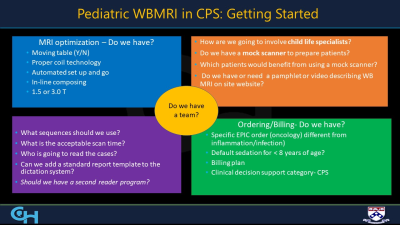Pediatric WBMRI in CPS: Getting Started
1Children's Hospital of Philadelphia, United States
Synopsis
This talk will review the evolving development of whole-body imaging protocols for pediatric patients with a known germline mutation. Harmonization of protocols and performance of clinical studies of focused on syndromes with cancer predisposition remain the most important initiatives in caring for this population. The challenges of tumor surveillance will also be addressed. The benefit of whole-body MRI in the pediatric population is clear with the most important factors being lack of ionizing radiation and early cancer detection potentially leading to aggressive treatment and greater chance for a cure.
Abstract
This talk will review the evolving development of whole-body imaging protocols for pediatric patients with a known germline mutation. Harmonization of protocols and performance of clinical studies of focused on syndromes with cancer predisposition remain the most important initiatives in caring for this population. The challenges of tumor surveillance will also be addressed. The benefit of whole-body MRI in the pediatric population is clear with the most important factors being lack of ionizing radiation and early cancer detection potentially leading to aggressive treatment and greater chance for a cure.Acknowledgements
CHOP Cancer Predisposition Syndrome Clinic
American Cancer Association for Cancer Research.
Li Fraumeni Syndrome Association.
Dr. Mary-Louise Greer and Dr. Andrea Doria, The Hospital for Sick Children, Toronto
References
•Tunariu N et al. What’s new for Clinical Whole-Body MRI (WB-MRI) in the 21st Century. BJR 125th Anniversary: REVIEW ARTICLE. Br J Radiol. 2020 •
Hegenschedi K et al, Potentially relevant incidental findings on research whole-body MRI in the general adult population: frequencies and managagement. Eur Radiol 2013;23:816.
•HegedÜs P et al, How to report incidental findings from population whole-body MRI: view of participants in German national cohort. Eur Radiol 2019 •
Saya S et al , Baseline results from the UK Signify study: a whole body screening in TP53 mutation carriers and matched controls. Fam Cancer 2017, 16 433-40. •
Villani A et al, Biochemical and imaging surveillance in germline TP53 mutation carriers with Li-Fraumeni syndrome: 11year follow-up of a prospective observational study. Lancet Oncol 2016. •
Schafer JF et al. Whole-Body magnetic resonance imaging in pediatric oncology-recommendations by the Oncology Task Force of the ESPR, Pediatric Radiology, 2020 •Greer et al. Pediatric Cancer Predisposition Imaging: Focus on WBMRI, Clin Cancer Research, 2017 •
Carter AJ, Greer ML et al. Mock MRI: reducing the need for anaesthesia in children. Pediatr Radiol 2010
Anupindi SA, et al. Diagnostic performance of whole-body MRI as a tool for cancer screening in children with genetic cancer-predisposing conditions. AJR 2015
